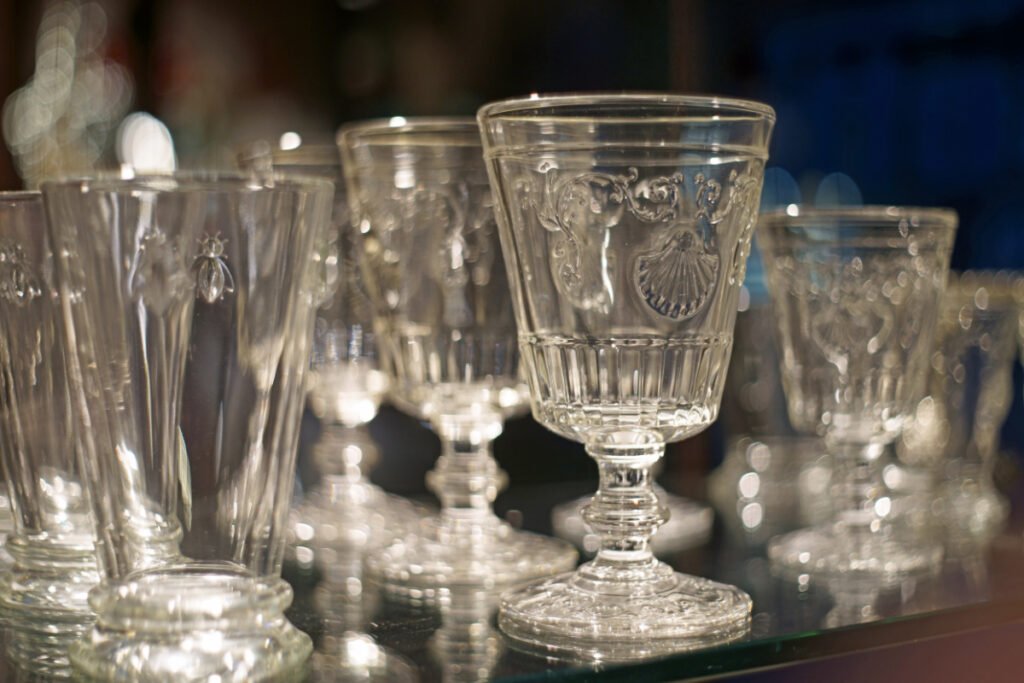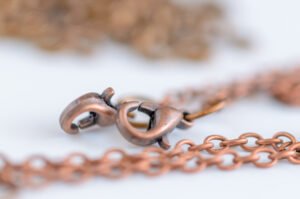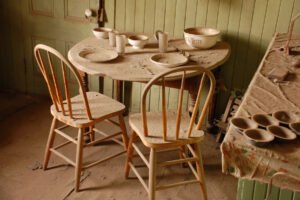We all have drinking glasses at home, right? But do you know that the crude ones might earn you thousands? And it’s not just about money! These heirlooms also have rare cut glass patterns and motifs, which literally lure antique collectors worldwide!
But, if you want to resell your old glass, you must know its true worth! This will also save you from scams. So, today, I bring you this ultimate antique drinking glasses identification guide to help you spot the right features and set a good price for your antique glasses!
Key Takeaways
- You can spot antique drinking glasses by their pontil marks, yellow patina, and bubbles. Also, see if they have twisted rims and seams for a rare make.
- You’ll get old drinking glasses in three types – baluster, twisted, and facet stem. Of these, the baluster ones are rare and precious!
- Pick drinking glasses with stone, cut glass, bronze, or copper walls for the best returns.
- Check if your glass’s base has etched logos or signs to check its brand. Also, look for clear, black, pink, or yellow stems for good value.
Identification Features of Antique Drinking Glasses

Take a magnifier and observe your glass’s surface! Do you see any handmade marks like bubbles and scratches? Or is there a yellowish film on the surface? If yes, it’s surely an old drinking glass costing $200 – 300.
But if you don’t have a magnifier, you can also look for these features:
- Deep and circular pontil or hand-blown rod marks on the base and rims
- Transparent, White, or Tinted sides with pressed, cut, or depressed glass carvings
- Air twist or spiral stems with 3 – 4 ply glass and threaded walls
- 10 – 15 cm tall walls with a 7- 8 cm top and 12 – 14 ounce holders
History & Evolution of Drinking Glasses
Have you ever seen historical, daily-use goods in museums? You’ll see a thick, handmade body with most of them. And even their materials – clay and stone; are local! Well, it’s the same with the old drinking glass! So, most of the 1600s ones are barrel-like and heavy!
The usable collectibles start from the 1700s. Like, these are plain and cylindrical to hold more. Makers also used seams and rims for easy pouring. But, these glasses were very brittle and deformed easily. So, people stopped using them, making them rare today!
The 1800s and 1900s are more pressed glass and metal! So, you’ll get all the polished metal and carved glass pieces from this era! Most will also have thinner stems, thread designs, and flat bases. But, these are really new and low-valued at $100 – 120.
3 Types of Antique Drinking Glass (With Values)
Interestingly, different artists made different glass patterns in old times. So, each one priced its design differently, leading to the three types below!
1. Antique Baluster Glass

Baluster glasses are more like vintage vases with round knobs and stems. They have folded feet, angular rims, and a U-shaped cup at the top. Plus, they might have a whitish or orangish tint, costing $1000 – 1200.
Next, see if they have terraced bases, curved rings, and seams. If yes, you can hike their cost by 4 – 5%.
2. Old Twisted Drinking Glass
Does your antique drinking glass have twisted or looped stems? Or do you see a 5-6 inch central rod with dual tints and patterns? If yes, it must be an old twisted drinking glass worth $300 – 400. What’s more? You’ll also see clear, beige, and cream sides with this one!
3. Vintage Facet Stem Drinking Glass

If your glass stem has square or hexagon motifs, it’s a facet stem glass. You can also look for ovoid bowls and solid bases to identify these! Also, check their weight. If they weigh about 5 – 6 ounces, price them up to $400. If not, they cost $300 – 350.
6 Steps to Identify & Value a Vintage Drinking Glass
If you can’t categorize your old drinking glass, don’t worry! You can still identify it and assess its worth using the following six steps.
1. Track the Glass’s Manufacturing Date & Age

There’s hardly any antique lover who doesn’t love old, handmade glasses! And that’s why the 1700s ones are always in demand! But if you want a cheaper option, try the branded ones from the 1800s! And if the polished ones attract you, the 1900s glasses are best!
But how would you trace the age of your piece? Well, check out the cues below!
How Does the 1700s Drinking Glass Look?
Check if your drinking glass has large knobs, domed feet, and curved seams. Also, if it has yellowish walls, pontil marks, and hand-blown bodies, it’s the 1700s drinking glass costing $800 – 1000. Also, check its stem! If it’s plain and solid, hike the cost by 4 – 5%.
How Do You Know If Your Drinking Glass Is from the 1800s?
The 1800s glasses are fancy! Like, you’ll find carved or pressed glass patterns and etched motifs with this one. Enamel rods, tinted designs, and 5 – 6 inch glass stems would also be common. And if you see small flakes or gilts on its surface, price the piece up to $500.
How Do You Pick a 1900s Drinking Glass?
Touch your drinking glass’s surface. If the walls look shiny and the design feels blunt, it might be a 1900s glass. You’ll also see etched patent numbers and brand signs with this one. Plus, it’ll have standard mold forms and bases. So, this one will be cheaper, only up to $200.
Here are some antique drinking glass patent numbers for help!
| Year | Age | Patent Number | Average Valuation |
| 1900s | 123 years | US2541581A | $150 – 200 |
| 1900s | 123 years | D551,502 | $100 – 120 |
| 1900s | 123 years | D244,295 | $100 – 120 |
Get drinking glasses with inverted baluster stems and funnel or bell-shaped bowls for an old make.
2. Analyze the Glass Materials

You might have seen the typical glass and steel glasses in your kitchen. But antique ones had many more materials. For example, makers used local stone or bone first. The next royal ones were gold or silver. And post industrial era, makers used steel and enamel!
Here’s how much you’ll earn for some old drinking glass materials:
| Old Drinking Glass Materials | Average Valuation |
| Natural Stone, Bone, Hide | $1000 – 1200 |
| Cut or Pressed Glass | $800 – 850 |
| Alloyed or Carbide Steel | $400 – 500 |
| Silver, Gold, or Copper | $950 – 1000 |
| Stainless Steel or Polished Steel | $100 – 200 |
| Clear & Tinted Enamel | $40 – 50 |
Get drinking glasses with hammered, satin, chisel-cut, or bubbled finishes for an old make.
3. Observe the Shapes
The earlier, handmade drinking glasses look more like a tumblr or barrel. You might also see regular curved or cylindrical glasses at your shop. But those are new and cheap! And even pitcher-like or squarish glasses are a big no for good returns.
Here are the exact values of some vintage glass shapes for help!
| Old Drinking Glass Shapes | Average Valuation |
| Tumbler or Barrel | $900 – 1000 |
| Solid stem, Twisted or Hollow Stem | $700 – 800 |
| Flute or Inverted Triangle | $500 – 600 |
| Pitcher – Shaped | $400 – 450 |
| Cylindrical / Curved | $100 – 120 |
| Square / Cubical | $60 – 70 |
Pick vintage drinking glasses with multispiral, corkscrew, or double spiral bases for more returns.
4. Observe the Glass Colors

You’ll get antique drinking glasses in three colors – clear, oxidized, and tinted. Of these, the clear ones are old and handmade. On the other hand, the oxidized ones are composite, while the tinted ones are mold-made. So, their values vary accordingly!
Want to know the exact value of each drinking glass color? Check out this list!
| Old Drinking Glass Colors | Average Valuation |
| Clear Glass & Transparent | $100 – 120 |
| Black, White & Gray | $80 – 100 |
| Pink, Cranberry, Red (Gold Oxide) | $60 – 70 |
| Cobalt, Navy (Cobalt Salts) | $40 – 50 |
| Golden, Yellow, Amber (Sulphur) | $60 – 70 |
| Green, Jadeite (Uranium Glass) | $40 – 50 |
5. Check the Antique Drinking Glass Brands

Rotate your drinking glass and check its base. Does it have any stamped logos or maker marks on it? If yes, it’s a branded piece! Now, you just have to scroll eBay for the company, and you’ll get its price! Also, see if it has some dual patterns or speckles to hike the cost!
Here are some easy-to-collect drinking glass brands for help!
| Old Drinking Glass Name | Manufacturer | Average Valuation |
| Central Park Clear 12 oz Glass | Anchor Hocking | $70 – 100 |
| Industrial Glasses | Cera | $400 – 450 |
| Green Square Double Glasses | Cera | $100 – 120 |
| Owl, Crescent Moon Glass | Couroc | $50 – 60 |
Avoid getting chipped, cracked, or faded glasses, as those might lose their value by 10 – 12%.
6. Check the Model’s Rarity
Rare, limited-edition models are obviously more precious and asked for than others. So, if your drinking glass has any royal stamps, you can hike its cost by 10 – 12%. Similarly, you’ll get $2,000 – $3,000 if your glass has rare, dual-colored streaks and patterns.
And here are some rare, top-selling glasses at any antique bid:
| Rare Drinking Glasses | Year | Average Value |
| Five Knop Air Twist Wine Glass | 1750 | $5,200 – $6,000 |
| Georgian Beilby Enameled Opaque Twist Ale Glass | 1765 | $3,000 – $3,200 |
| Four Knop Air Twist On Domed Foot Wine Glass | 1750 | $2,500 – $3,000 |
| Large Queen Ann Baluster Mead Glass | 1710 | $2,000 – $2,500 |
| Armorial Lauenstein Glass Goblet | 1750 | $1,000 – $1,200 |
What Are Old Whisky Drinking Glasses Called?
Old whisky glasses are also called whisky tumblers. You can spot these by their straight walls, minimal patterns, and grooved bases costing $1200 – 1500.
Which Glass Is Used to Make an Antique Drinking Glass?
Antique drinking glasses are generally made from boro-silicate or soda-lime glass. Both are transparent but look green on the sides.
How Do You Clean Old, Cloudy Drinking Glasses?
Mix a 1:2 solution of vinegar and water and soak your glass for about 30 mins. Now, rinse the glass with mild soap and water and leave it dry.
People love getting antique drinking glasses for their unique cut glass patterns! But now, we know they have many more features like stems, rims, and seams. Plus, you must observe its color, brand, and shape to learn the right cost! And our detailed guide will surely help you!
You can also pair your drinking glasses with antique liquor bottles and decanters. And we already have ready guides to help you get the right ones!









